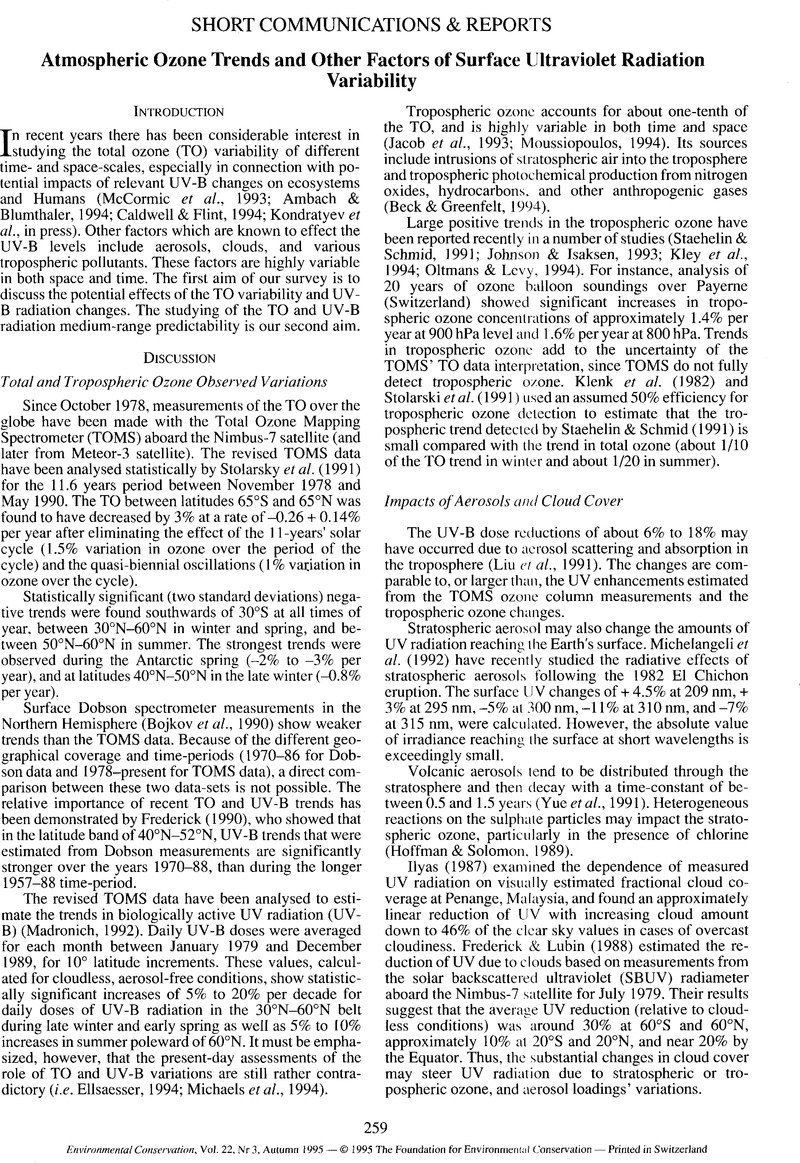Crossref Citations
This article has been cited by the following publications. This list is generated based on data provided by Crossref.
Diamond, Stephen A.
Peterson, Gregory S.
Tietge, Joseph E.
and
Ankley, Gerald T.
2002.
Assessment of the Risk of Solar Ultraviolet Radiation to Amphibians. III. Prediction of Impacts in Selected Northern Midwestern Wetlands.
Environmental Science & Technology,
Vol. 36,
Issue. 13,
p.
2866.
Vlamakis, A.
2005.
Tropopause and total ozone at mid‐latitudes.
International Journal of Remote Sensing,
Vol. 26,
Issue. 16,
p.
3605.
Tsivola, E.
Christodoulakis, J.
and
Charami, E.
2005.
Comparison between the total ozone observations made by ground‐based and satellite‐borne instrumentation at Athens, Greece.
International Journal of Remote Sensing,
Vol. 26,
Issue. 16,
p.
3561.
Theodorakopoulos, P.
and
Theodorakopoulou, K.
2005.
Investigation of the erythemal ultraviolet trends in the greater Greece area: Implications to human health.
International Journal of Remote Sensing,
Vol. 26,
Issue. 16,
p.
3545.
Tzanis, C.
2005.
Ground‐based observations of ozone at Athens, Greece during the solar eclipse of 1999.
International Journal of Remote Sensing,
Vol. 26,
Issue. 16,
p.
3585.
Efstathiou, M. N.
Feretis, H.
Tzanis, C.
and
Christodoulakis, J.
2005.
Observed association between air pollution and the biologically effective solar ultraviolet irradiance.
International Journal of Remote Sensing,
Vol. 26,
Issue. 16,
p.
3487.
Efstathiou, M. N.
2005.
The planetary waves in total ozone over Antarctica.
International Journal of Remote Sensing,
Vol. 26,
Issue. 16,
p.
3389.
Badarinath, K. V. S.
Kharol, Shailesh Kumar
Krishna Prasad, V.
Kaskaoutis, D. G.
and
Kambezidis, H. D.
2008.
Variation in aerosol properties over Hyderabad, India during intense cyclonic conditions.
International Journal of Remote Sensing,
Vol. 29,
Issue. 15,
p.
4575.
Chattopadhyay, Surajit
and
Chattopadhyay, Goutami
2008.
A factor analysis and neural network‐based validation of the Varotsos–Cracknell theory on the 11‐year solar cycle.
International Journal of Remote Sensing,
Vol. 29,
Issue. 9,
p.
2775.
Cracknell, Arthur P.
and
Varotsos, Costas A.
2008.
Editorial Comment – the Montreal Protocol.
International Journal of Remote Sensing,
Vol. 29,
Issue. 19,
p.
5455.
Abakumova, G. M.
Gorbarenko, E. V.
Nezval, E. I.
and
Shilovtseva, O. A.
2008.
Fifty years of actinometrical measurements in Moscow.
International Journal of Remote Sensing,
Vol. 29,
Issue. 9,
p.
2629.
Sushkevich, T. A.
2008.
Pioneering remote sensing in the USSR. 2. Global spherical models of radiation transfer.
International Journal of Remote Sensing,
Vol. 29,
Issue. 9,
p.
2599.
Yegorov, A. D.
Potapova, I. A.
and
Rzhonsnitskaya, YU. B.
2008.
Atmospheric aerosols measurements and the reliability problem.
International Journal of Remote Sensing,
Vol. 29,
Issue. 9,
p.
2449.
Budak, V. P.
and
Korkin, S. V.
2008.
The aerosol influence upon the polarization state of the atmosphere solar radiation.
International Journal of Remote Sensing,
Vol. 29,
Issue. 9,
p.
2469.
Varotsos, Costas A.
2008.
The 20th anniversary of the Montreal Protocol and the unexplainable 60% of ozone loss.
Environmental Science and Pollution Research,
Vol. 15,
Issue. 6,
p.
448.
Tzanis, C.
Varotsos, C.
and
Viras, L.
2008.
Impacts of the solar eclipse of 29 March 2006 on the surface ozone concentration, the solar ultraviolet radiation and the meteorological parameters at Athens, Greece.
Atmospheric Chemistry and Physics,
Vol. 8,
Issue. 2,
p.
425.
Kozoderov, V. V.
and
Dmitriev, E. V.
2008.
Remote sensing of soils and vegetation: regional aspects.
International Journal of Remote Sensing,
Vol. 29,
Issue. 9,
p.
2733.
Ghude, Sachin D.
Singh, Sachchidanand
Kulkarni, P. S.
Kumar, A.
Jain, S. L.
Singh, R.
Arya, B. C.
and
Shahnawaz
2008.
Observations and model calculations of direct solar UV irradiances in the Schirmacher region of east Antarctica.
International Journal of Remote Sensing,
Vol. 29,
Issue. 20,
p.
5907.
Christodoulakis, J.
Tzanis, C.
and
Varotsos, C.
2008.
Technical Report: Standardization of the Athens Dobson spectrophotometer versus Reference Dobson spectrophotometer 064.
International Journal of Remote Sensing,
Vol. 29,
Issue. 7,
p.
1917.
Kulkarni, Pavan S.
Jain, S. L.
Ghude, Sachin D.
Arya, B. C.
Dubey, P. K.
and
Shahnawaz
2009.
On some aspects of tropospheric ozone variability over the Indo-Gangetic (IG) basin, India.
International Journal of Remote Sensing,
Vol. 30,
Issue. 15-16,
p.
4111.



